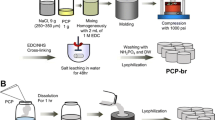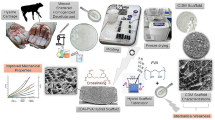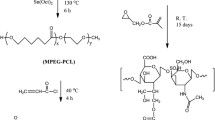Abstract
An ideal scaffold for cartilage tissue engineering should be biomimetic in not only mechanical property and biochemical composition, but also the morphological structure. In this research, we fabricated a composite scaffold with oriented structure to mimic cartilage physiological morphology, where natural nanofibrous articular cartilage extracellular matrix (ACECM) was used to mimic the biochemical composition, and synthetic PLGA was used to enhance the mechanical strength of ACECM. The composite scaffold has well oriented structure and more than 89% of porosity as well as about 107 μm of average pore diameter. The composite scaffold was compared with ACECM and PLGA scaffolds. Cell proliferation test showed that the number of MSCs in ACECM and composite scaffolds was noticeably bigger than that in PLGA scaffold, which was coincident with results of SEM observation and cell viability staining. The water absorption of ACECM and composite scaffolds were 22.1 and 10.2 times respectively, which was much higher than that of PLGA scaffolds (3.8 times). The compressive modulus of composite scaffold in hydrous status was 1.03 MPa, which was near 10 times higher than that of hydrous ACECM scaffold. The aforementioned results suggested that the composite scaffold has the potential for application in cartilage tissue engineering.








Similar content being viewed by others
References
Langer R, Vacanti JP. Tissue engineering. Science. 1993;260:920–6.
Nerem RM, Sambanis A. Tissue engineering: from biology to biological substitutes. Tissue Eng. 1995;1:3–13.
Jeong SI, Kim SY, Cho SK, Chong MS, Kim KS, Kim H, et al. Tissue-engineered vascular grafts composed of marine collagen and PLGA fibers using pulsatile perfusion bioreactors. Biomaterials. 2007;28:1115–22.
Hui TY, Cheung KMC, Cheung WL, Chan D, Chan BP. In vitro chondrogenic differentiation of human mesenchymal stem cells in collagen microspheres: influence of cell seeding density and collagen concentration. Biomaterials. 2008;29:3201–12.
Yamane S, Iwasaki N, Majima T, Funakoshi T, Masuko T, Harada K, et al. Feasibility of chitosan-based hyaluronic acid hybrid biomaterial for a novel scaffold in cartilage tissue engineering. Biomaterials. 2005;26:611–9.
Zhang L, Ao Q, Wang AJ, Lu GY, Kong LJ, Gong YD, et al. A sandwich tubular scaffold derived from chitosan for blood vessel tissue engineering. J Biomed Mater Res Part A. 2006;77A:277–84.
Wang Y, Bella E, Lee CS, Migliaresi C, Pelcastre L, Schwartz Z, et al. The synergistic effects of 3-D porous silk fibroin matrix scaffold properties and hydrodynamic environment in cartilage tissue regeneration. Biomaterials. 2010;31:4672–81.
Hu J, Feng K, Liu XH, Ma PX. Chondrogenic and osteogenic differentiations of human bone marrow-derived mesenchymal stem cells on a nanofibrous scaffold with designed pore network. Biomaterials. 2009;30:5061–7.
Jung Y, Park MS, Lee JW, Kim YH, Kim SH, Kim SH. Cartilage regeneration with highly-elastic three-dimensional scaffolds prepared from biodegradable poly (L-lactide -co-3-caprolactone). Biomaterials. 2008;29:4630–6.
Uematsu K, Hattori K, Ishimoto Y, Yamauchi J, Habata T, Takakura Y, et al. Cartilage regeneration using mesenchymal stem cells and a three-dimensional poly lactic-glycolic acid (PLGA) scaffold. Biomaterials. 2005;26:4273–9.
Wen XJ, Tresco PA. Fabrication and characterization of permeable degradable poly(D, L-lactide-co-glycolide) (PLGA) hollow fiber phase inversion membranes for use as nerve tract guidance channels. Biomaterials. 2006;27:3800–9.
Richard RD, Aldor RB, Veronique M, Sandra S, Alastair F, Simon G, et al. In vivo characterization of a novel bioresorbable poly(lactide-co-glycolide) tubular foam scaffold for tissue engineering applications. J Mater Sci Mater Med. 2004;15:729–34.
Liu Y, Bharadwaj S, Lee SJ, Atala A, Zhang YY. Optimization of a natural collagen scaffold to aid cell–matrix penetration for urologic tissue engineering. Biomaterials. 2009;30:3865–73.
Zhao YL, Zhang S, Zhou JY, Wang JL, Zhen MC, Liu Y, et al. The development of a tissue-engineered artery using decellularized scaffold and autologous ovine mesenchymal stem cells. Biomaterials. 2010;31:296–307.
Zhang XJ, Deng ZH, Wang HL, Yang ZH, Guo WH, Li Y, et al. Expansion and delivery of human fibroblasts on micronized acellular dermal matrix for skin regeneration. Biomaterials. 2009;30:2666–74.
Yang Q, Peng J, Guo QY, Huang JX, Zhang L, Yao J, et al. A cartilage ECM-derived 3-D porous acellular matrix scaffold for in vivo cartilage tissue engineering with PKH26-labeled chondrogenic bone marrow-derived mesenchymal stem cells. Biomaterials. 2008;29:2378–87.
Gratz KR, Wong VW, Chen AC, Fortier LA, Nixon AJ, Sah RL. Biomechanical assessment of tissue retrieved after in vivo cartilage defect repair: tensile modulus of repair tissue and integration with host cartilage. J Biomech. 2006;36:138–46.
Gotterbarm T, Richter W, Jung M, Berardi Vilei S, Mainil-Varlet P, Yamashita T, et al. An in vivo study of a growth-factor enhanced, cell free, two-layered collagen–tricalcium phosphate in deep osteochondral defects. Biomaterials. 2006;27:3387–95.
Lanfer B, Seib FP, Freudenberg U, Stamov D, Bley T, Bornhäuser M, et al. The growth and differentiation of mesenchymal stem and progenitor cells cultured on aligned collagen matrices. Biomaterials. 2009;30:5950–8.
Lanfer B, Hermann A, Kirsch M, Freudenberg U, Reuner U, Werner C, et al. Directed growth of adult human white matter stem cell-derived neurons on aligned fibrillar collagen. Tissue Eng Part A. 2010;16:1103–13.
Tan HP, Wu JD, Lao LH, Gao CY. Gelatin/chitosan/hyaluronan scaffold integrated with PLGA microspheres for cartilage tissue engineering. Acta Biomater. 2009;5:328–37.
Dai WD, Kawazoe N, Lin XT, Dong J, Chen GP. The influence of structural design of PLGA/collagen hybrid scaffolds in cartilage tissue engineering. Biomaterials. 2009;30:1–12.
Wu SC, Chang JK, Wang CK, Wang GJ, Ho ML. Enhancement of chondrogenesis of human adipose derived stem cells in a hyaluronan-enriched microenvironment. Biomaterials. 2010;31:631–40.
Shi GX, Cai Q, Wang CY, Lu N, Wang SG, Bei JZ. Fabrication of cell scaffold of poly(L-lactic acid) and poly(L-lactic-co-glycolic acid) and biocompatibility. Polym Adv Technol. 2002;13:227–32.
Yang F, Qu X, Cui WJ, Bei JZ, Yu FY, Lu SB, et al. Manufacturing and morphology structure of polylactide-type microtubules orientation structured scaffolds. Biomaterials. 2006;27:4923–33.
Ma PX, Zhang RY. Microtubular architecture of biodegradable polymer scaffolds. J Biomed Mater Res. 2001;56:469–77.
Yang HN, Park JS, Na K, Woo DG, Kwon YD, Park KH. The use of green fluorescence gene (GFP)-modified rabbit mesenchymal stem cells (rMSCs) co-cultured with chondrocytes in hydrogel constructs to reveal the chondrogenesis of MSCs. Biomaterials. 2009;30:6374–85.
Wise JK, Yarin AL, Megaridis CM, Cho M. Chondrogenic differentiation of human mesenchymal stem cells on oriented nanofibrous scaffolds: engineering the superficial zone of articular cartilage. Tissue Eng Part A. 2009;15:913–21.
Li WJ, Jiang YJ, Tuan RS. Chondrocyte phenotype in engineered fibrous matrix is regulated by fiber size. Tissue Eng. 2006;12:1775–85.
Roosa SM, Kemppainen JM, Moffitt EN, Krebsbach PH, Hollister SJ. The pore size of polycaprolactone scaffolds has limited influence on bone regeneration in an in vivo model. J Biomed Mater Res A. 2010;92:359–68.
Yang F, Murugan R, Wang S, Ramakrishna S. Electrospinning of nano/micro scale poly (L-lactic acid) aligned fibers and their potential in neural tissue engineering. Biomaterials. 2005;26:2603–10.
Lee M, Wu BM, Dunn JC. Effect of scaffold architecture and pore size on smooth muscle cell growth. J Biomed Mater Res A. 2008;87:1010–6.
Kasten P, Beyen I, Niemeyer P, Luginbuhl R, Bohner M, Richter W. Porosity and pore size of beta-tricalcium phosphate scaffold can influence protein production and osteogenic differentiation of human mesenchymal stem cells: an in vitro and in vivo study. Acta Biomater. 2008;4:1904–15.
Campbell CE, von Recum AF. Microtopography and soft tissue response. J Invest Surg. 1989;2:51–74.
Deligianni DD, Katsala ND, Koutsoukos PG. Effect of surface roughness of hydroxyapatite on human bone marrow cell adhesion, proliferation, differentiation and detachment strength. Biomaterials. 2001;22:87–96.
Kuroda R, Isada K, Matsumoto T, Akisue T, Fujioka H, Mizuno K, et al. Treatment of a full-thickness articular cartilage defect in the femoral condyle of an athlete with autologous bone-marrow stromal cells. Osteoarthr Cartil. 2007;15:226–31.
Wakitani S, Imoto K, Yamamoto T, Saito M, Murata N, Yoneda M, et al. Human autologous culture expanded bone marrow mesenchymal cell transplantation for repair of cartilage defects in osteoarthritis knees. Osteoarthr Cartil. 2002;10:199–206.
Acknowledgments
This study was funded by the National Natural Science Foundation of China (30973047, 2080409), National High-Tech Research and Development Program (2005CB522704, 2007AA021902), National Science and Technology Supportive Program (2006BAI16B04).
Author information
Authors and Affiliations
Corresponding author
Additional information
Xifu Zheng and Fei Yang contribute equally to this manuscript.
Rights and permissions
About this article
Cite this article
Zheng, X., Yang, F., Wang, S. et al. Fabrication and cell affinity of biomimetic structured PLGA/articular cartilage ECM composite scaffold. J Mater Sci: Mater Med 22, 693–704 (2011). https://doi.org/10.1007/s10856-011-4248-0
Received:
Accepted:
Published:
Issue Date:
DOI: https://doi.org/10.1007/s10856-011-4248-0




